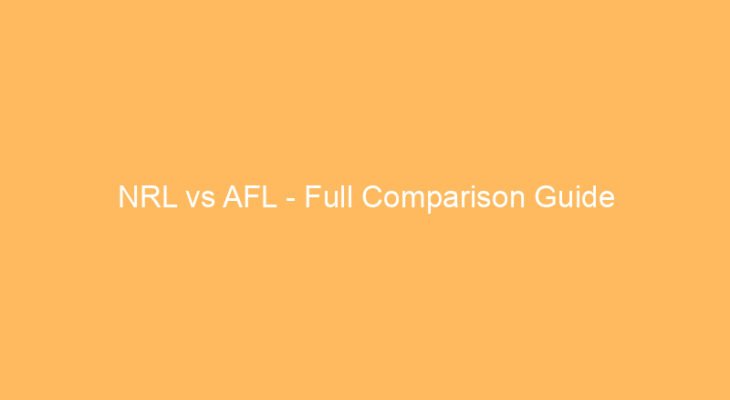Key Takeaways
- NRL is characterized by its intense physical contact and set-piece plays focusing on powerful tackles and strategic scrums,
- AFL emphasizes high-speed ball movement and aerial contests, requiring agility and quick decision making.
- The scoring methods differ, with NRL awarding points for tackles and tries, while AFL relies on kicking goals and scoring behinds.
- Game pace varies, NRL features structured plays with frequent stoppages, whereas AFL is faster with continuous play and less interruption.
- Fan culture and stadium atmosphere reflect regional loyalties, with NRL being more popular in New South Wales and Queensland, AFL dominating in Victoria and Western Australia.
What is NRL?
The National Rugby League (NRL) is a professional rugby league competition held primarily in Australia and New Zealand. It features teams competing in a fast-paced contact sport that combines strategic team plays with physical strength.
Physicality and Contact
NRL is renowned for its high-impact tackles and aggressive forward play, making it a tough sport to watch. The emphasis on physical dominance defines much of the game’s excitement.
Players engage in intense collisions, which test endurance and resilience. Although incomplete. This physical aspect makes NRL a sport that rewards strength and tactical aggression.
Game Structure and Rules
The game is played over 80 minutes divided into two halves, with six tackles per possession. Teams aim to score tries by grounding the ball in the opponent’s in-goal area.
Field positioning and set-piece plays like scrums and line-outs are critical. Penalties and strategic kick options are used to gain territorial advantage.
Major Competitions
The NRL season culminates in the finals series, leading to the Grand Final which is a major sporting event. It attracts massive crowds and television audiences nationwide.
Clubs compete annually, with some like the Sydney Roosters and Melbourne Storm having strong histories. The league also supports state and international matches.
Player Roles and Positions
Positions range from powerful forwards to agile backs, each with specific roles on the field. Players require a mix of speed, strength, and tactical awareness.
Key roles include the halfback directing play, the fullback providing defensive cover, and the props leading physical confrontations.
What is AFL?
The Australian Football League (AFL) is a professional competition centered around Australian rules football, played in Australia. It features a fast, high-scoring game that combines skill, speed, and aerial contests.
Gameplay and Skills
AFL involves kicking, catching, and handballing a leather ball across a large oval field. The game is known for its high-flying marks and quick ball movement.
Players need exceptional agility and reflexes to outmaneuver opponents and execute precise kicks. Although incomplete. The game’s flow relies on continuous, fast-paced action.
Field and Play Dynamics
The oval-shaped field allows for expansive play, with players moving in all directions. Marks and quick passes enable dynamic attacking strategies.
Scoring occurs when players kick the ball through goalposts, with points awarded for goals and behinds. Defensive setups are crucial to prevent scoring chances.
Major Tournaments
The AFL season is highlighted by the finals series culminating in the Grand Final, a major sporting spectacle watched nationwide. It features the best teams and players of the year.
Regular season matches are played across various Australian states, fostering regional rivalries and community engagement. The league also promotes development pathways for young athletes.
Player Specializations
Players specialize as midfielders, forwards, or defenders, each with distinct responsibilities. Midfielders control the game’s tempo, while forwards aim to score.
Athleticism and tactical intelligence are vital, with players needing endurance for continuous running and skill for precise kicks and catches.
Comparison Table
Below is a comparison of key aspects between NRL and AFL:
| Aspect | NRL | AFL |
|---|---|---|
| Playing Field | Rectangular, 100m long | Oval-shaped, much larger |
| Match Duration | 80 minutes, two halves | Around 120 minutes, four quarters |
| Ball Type | Oval-shaped rugby ball | Oval-shaped Australian rules ball |
| Scoring Method | Tries + conversions, points for tackles | Goals + behinds, points for kicks |
| Number of Players | 13 players per team | 18 players per team |
| Play Style | Structured, set-piece focus | Continuous, fast-paced movement |
| Contact Level | High-impact tackles, scrums | Less contact, more aerial contests |
| Fan Base | Strong in NSW and Queensland | Predominantly in Victoria, WA, SA |
| Season Length | 26 rounds plus finals | 23 rounds plus finals |
| Major Trophy | NRL Premiership Trophy | Premiership Cup |
| Game Pace | Moderate, with stoppages | Fast, continuous |
Key Differences
- Field Shape is clearly visible in the rectangular versus oval playing surfaces.
- Game Flow revolves around structured plays in NRL while AFL is more fluid and free-flowing.
- Scoring Methods is noticeable when comparing tries and goals, which are distinct to each game.
- Player Count relates to team sizes, with NRL having fewer players on the field at once.
FAQs
How do injuries differ between NRL and AFL?
NRL injuries involve concussions and muscle strains due to physical tackles, while AFL injuries include sprains from rapid directional changes and aerial falls. The contact intensity and playing style influence the injury types specific to each sport.
What role does weather play in match outcomes?
Weather conditions impact both games, with rain causing slippery fields affecting grip and kicking accuracy. Wind can also influence goal accuracy, especially in AFL where long kicks are common.
Are there unique training routines for players?
NRL players focus heavily on strength and tackling drills, while AFL athletes emphasize endurance, agility, and aerial skills. Each sport’s demands shape their specialized training programs.
How do regional rivalries influence the leagues?
Regional loyalties are strong, with NRL rivalries centered around state pride in NSW and Queensland. AFL rivalries are deeply rooted in Victoria and Western Australia, creating passionate local derbies that draw large crowds.




